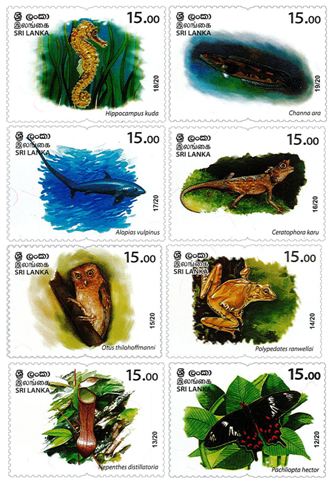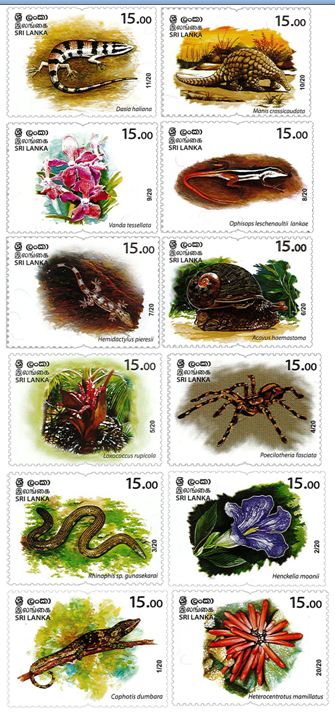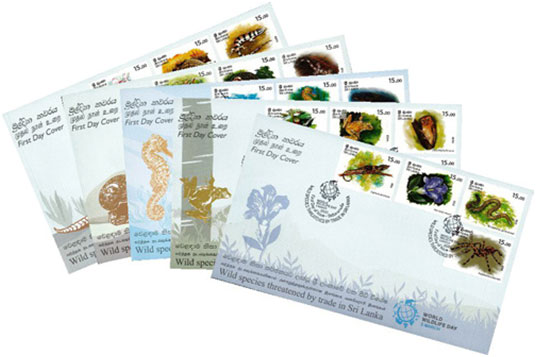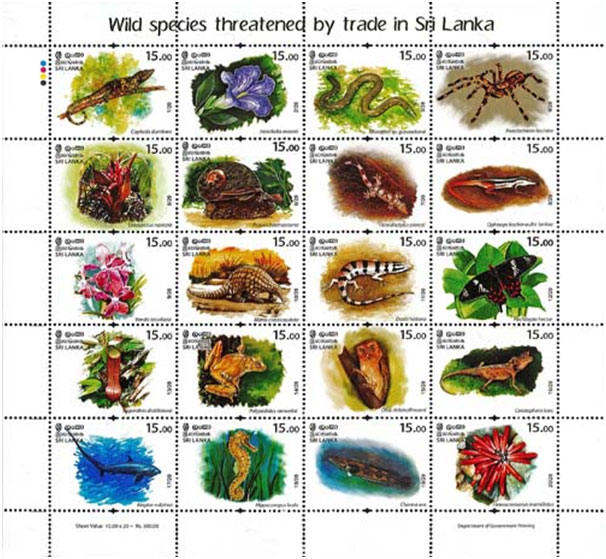

Home/Active Page


The Philatelic Bureau of the Department of Posts has issued twenty new postage stamps depicting Wild Species Threatened by Trade in Sri Lanka in the denomination of Rs. 15.00 each on March 3, 2020.
| Date of Issue | March 3, 2020 |
| Denomination | Rs.15.00 x 20 |
| Catalogue No: | CSL 2368 - CSL 2387 |
| Stamp Designer | Pulasthi Ediriweera. Venura Bartholamues. Wathmi de Zoysa |
Stamp Size: | 41mm x 30mm |
| Sheet Composition: | 20 stamps per sheet |


A slow moving tiny agamid that lives an arboreal life, well blended in its habitat in the Knuckles landscape. This perfectly camouflaged species endemic to the island and with its restricted distribution, typically found above 800 m above sea level. As it is newly described species there is a severe threat due to over collection. The species is considered critically endangered (CR) under IUCN Red data Book (2014).
A considerable large herb about 1-1.5m tall. Grow on steep rocky faces in lowland wet forests. Light green leaves covered with thick silvery hairs and large conical shaped purple-blue large flowers are prominent. Endemic to Sri Lanka. Found as in small populations.
A burrowing species of snake point endemic to the Knuckles region. This newly described very attractive, rare snake species is threatened due to limited populations.
Commonly known as the Sri Lanka ornamental, the species is an endemic. These spiders are completely arboreal and the genus is the largest in this groups. It is endemic to central Sri Lanka. This species can be identified from other tiger spiders due to very narrow dark band on the femur of first pair of legs and by thin broken band on femur of fourth pair of legs
Small palm species, whole genus endemic to Sri Lanka. Grows in shady wet cliffs in lowland rain forests to lower mountain forest. Not common, small populations are found in in the locations.
This fairly large sized attractive and extremely colourful air-breathing land snail is endemic to the wet tropical jungles of Sri Lanka. They are active during the nocturnal hours. These snails were said to be used in the island's indigenous medicine specially as a remedy for a variety of aches and pains. The shells of these snail were quite abundantly found in excavation sites of the pre-historic caves such as the Batadomba, and Belilena which serves as evidence that the snails were consumed at large by the "Balangoda man" of the pre-historic era. With increased urbanization the populations are fast declining.
This is an endemic species of gecko found in the wet zone of Sri Lanka, and is a common species adopted to survive in a wide range of habitats in the urban households to tropical forests. During the past years, geckos were at a trend to be traded illegally and in many instances, it happened to be this species was subjected to be a target species.
This fast moving snake-eye lizard, can be found in typical savana grasslands of the Eastern and Uva provinces. Complete invasion of guinea grass species such as Panicum indicum, in its savana grasslands has become a major threat to the survival of this colourfully striped species.
It is an epiphytic orchid naturally growing in dry zone and intermediate zone margins. Very attractive, fragrant flowers with wide range of colours and shapes varying from grey, green, yellow, red etc. Although it is not endemic largest and unique flower variations are confined to Sri Lanka. Highly threatened due to habitat threat and over collections. –
The Indian pangolin is a nocturnal mammal.It is about 84–122 centimetres long from head to tailand weighs 10–16 kg. The pangolin possesses a pinkish-brown skin.It is an almost exclusive insectivores and principally subsists on ants and termites, which it catches with a specially adapted long, sticky tongue. The most noticeable characteristic of the pangolin is its massive, scaled armour, which covers its upper face and its whole body with the exception of the belly and the inside of the legs. The skin and scales make up about one-fourth to one-third of the total body mass of this species. Populations of the species is severely declined recently due to poaching for its meat and scales the species is currently considered the world’s most trafficked animal.It is listed as endangered (EN) under threatened category of IUCN Red data Book(2014).
This beautiful iconic banded skink is a complete arboreal species. Until quite recently the species was thought to be found in both Sri Lanka and the Western Ghats of India. However taxonomic findings revealed that the species is confined to Sri Lankan intermediate, dry, and arid zones and a fairly uncommon species mainly due to the fact that they are well adopted to hide in the crevices of barks of giant trees. Highly threatened, rare, endemic species.
This beautiful butterfly is not uncommon in lowlands of Sri Lanka. It has been threatened due to excessive use of agrochemicals and high trade threat. The species Included in CITES CoP 18 Logo.
Largest Carnivorous plant species occur in Sri Lanka. The leaf is adopted to developed a pitcher for to attract, catch and digest small animals (Insects). This climbing plant grows in wet moist seepages with high sunlight. Occurs only in lowland rain forests and forest edges. Species endemic to Sri Lanka.
This endemic and rare species of amphibian can only be found in a small area of the Gilimale Forest Reserve, of the Ratnapura District. Ranwella's horned tree frog is the only known horned amphibian from the island of Sri Lanka. As its name suggests the species has four horn like projections right behind its head.
It is the first new bird to be discovered in Sri Lanka in 2004 since 1868. The owl, a nocturnal bird has very specific habitats and behaviour. It is a rare, endemic species with limited populations confined to undisturbed rainforests of Sri Lanka.Andthey seem to be declining because of the loss of habitat and the degradation. It is listed as endangered (EN) under threatened category of IUCN Red data Book (2016).
This genus is endemic to Sri Lanka, while the species is known to be the smallest agamid lizard found in the island. No more than 4-5 cm in length from snout to vent, this perfectly camouflage species can only be found amid leaf litter of the dense forest floors in the Rakwana hills. Highly threatened species.
The tresher shark is a member of the family of the tresher sharks (Alopiidae) and the order of the mackerel sharks (Lamniformes). It is named for its long, elegant tail, that can be as long as the rest of its body and can be used to stun prey by hitting it. High trade threat. Included CITES CoP 18 Logo
Hippocampus kuda or the Estuarine seahorse is one of the most widely distributed seahorse species in the world. It occurs across the Indo-Pacific marine region and has also been recorded in the Mediterranean Sea. It is most commonly found in estuaries and shallow sheltered waters around coral reefs, seagrass meadows and mangroves. But can also be found in pelagic waters, often attached to driftwood or floating debris. Like all other seahorses it produces live young that are hatched in the brood pouch of the male. Hippocampus kuda is listed as Vulnerable in the IUCN Red List and is also listed in Appendix II of CITES. It is primarily threatened by by-catch in trawl fisheries and the collection for use in traditional medicines and for the marine aquarium trade.
Species endemic to SriLanka. Rare fish species recorded from both wet and dry-zones of low land. Recent study found only few specimens from the wet zone of southern and western Sri Lanka. Adult Giant snakehead can grow over meter long and prefers and deep pools in large rivers. The sexes are similar in appearance. The Giant Snakehead is listed as an Endangered species in the national red list 2012.
This species is a large sea urchin, with some specimens reaching over 8 cm in diameter, with spikes up to 10 cm. Most specimens are bright red, but brown and purple colorations are also seen. The spines may have a different colour from the body. Spines have a white ring at their stem and have alternating light and dark rings. The spines are rounded to triangular in cross-section and taper towards the tip. Surprisingly during the night the red spines turn into a chalky pink.
All rights reserved. All right to identify the Department of Posts as the Author and designer of this Bulleting has been asserted in accordance with the Copyright, Design and Patents Act 1988.No part to this publication may be reproduced, stored in or introduced into a retrieval system, or transmitted in any form or by and means (electronic, mechanical, photocopying, recording or otherwise) without the prior permission from the publisher. Any person who does and unauthorized act in relation to this publication may be liable to criminal prosecution and civil claims for damages.